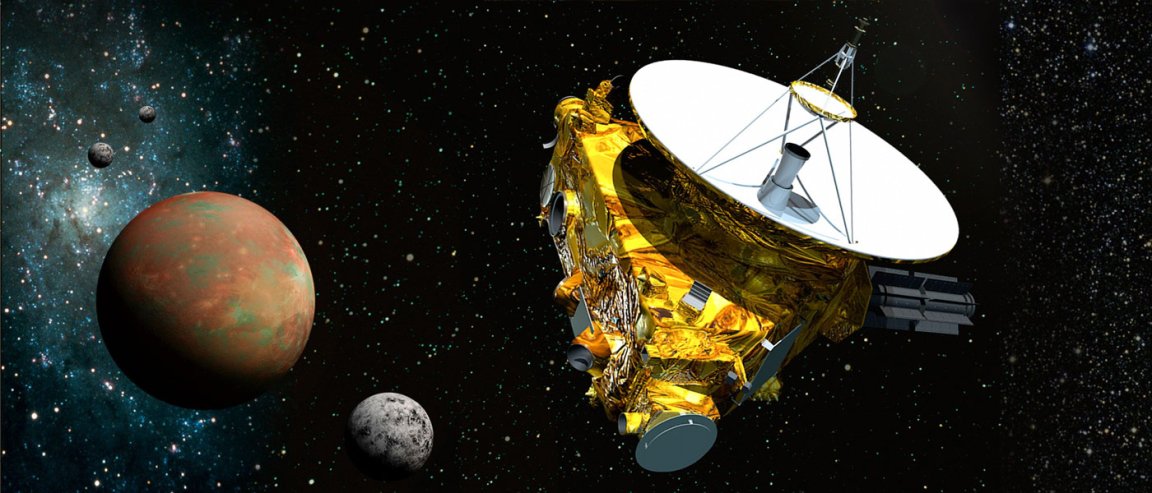
NASA’s New Horizons spacecraft has already reached its target destination: the dwarf planet Pluto. Now, new questions emerge about the probe’s fate. What will it explore next? How long will it be operational? When will it leave our solar system?
The answers to the first two questions seem simple, as we know that the craft is on its way to the Kuiper Belt to explore some of the icy objects found there (these are known as Kuiper Belt Objects or KBOs). It should have enough time to get a pretty good look at this distant part of our solar system, as it is expected to be functioning till 2026.
Recently, NASA announced that its specific target is 2014 MU69, a rocky and ice-covered object one billion miles beyond Pluto. Current estimates place it at just 45 kilometers (30 miles) wide; however, we will need to wait some time for its arrival, as it isn’t expected to have its rendezvous until January 2019.
The third question (when will New Horizons leave our solar system?) remains somewhat elusive.
Michael E. Summers, a professor of Planetary Sciences and Astronomy at the George Mason University in Fairfax, Virginia, and New Horizons co-investigator, admits that the question about leaving the solar system is baffling the scientific community.
“This is actually a rather difficult question to answer. The problem is how and where do you define the boundary of the solar system,” Summers told FQTQ (From Quarks to Quasars).
The point at which the solar system ends is not precisely defined because its outer boundaries are shaped by two separate forces: the solar wind and the Sun’s gravity. As it is currently estimated, the limit of the solar wind’s influence is about four times Pluto’s distance from the Sun. But the influence of the Sun’s gravity extends without limit. Although it gets weaker farther away from the Sun, there is no boundary at which it stops. Indeed, astronomers are still discovering objects that orbit in the outer solar system beyond Pluto.
“We know from the Voyager 1 spacecraft that the solar wind extends to at least 80 astronomical units (AU) from the Sun. But we also know of small bodies such as Sedna that have orbits much beyond that,” Summers said.
Sedna is one of the most distant known objects in the solar system. But currently, the most distant known object is the dwarf planet 2012 VP113. Both Sedna and 2012 VP113 were found near their closest approach to the Sun, but they both have orbits that go out to hundreds of AU, at which point they would be too faint to discover.
“Long period comets come from the Oort Cloud, which is a roughly spherical cloud of trillions of comets orbiting the sun at over 10,000 AU from the sun,” Summers noted.
So how do we define the point at which New Horizons will really leave the solar system?
As was the case with the Voyager 1 spacecraft, NASA announced in March 2013 that its probe left our planetary system and entered interstellar space after it detected a marked change in the plasma environment when it reached a distance of nearly 125 AU from the Sun. The Voyager 2 is expected to do the same within a few years.
The New Horizons mission is believed to reach the same distance around 2040, but the exact time remains uncertain—it just depends on when it detects significant changes in the density of energetic particles. Interestingly, although New Horizons was launched far faster than any outbound probe before it, it will never overtake either Voyager 1 or Voyager 2 as the most distant human-made object from Earth, thanks to gravity assists they received from Jupiter and Saturn. When New Horizons reaches the distance of 100 AU in 2038, it will be travelling at about 46,600 kph (29,000 mph), around 14,300 kph (8,900 mph) slower than Voyager 1 at that distance.
The New Horizons spacecraft is now more than 4.8 billion kilometers (3 billion miles) from Earth, and more than 69 million kilometers (43 million miles) beyond Pluto. NASA reports that the probe is healthy and all systems are operating normally.